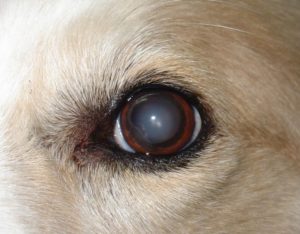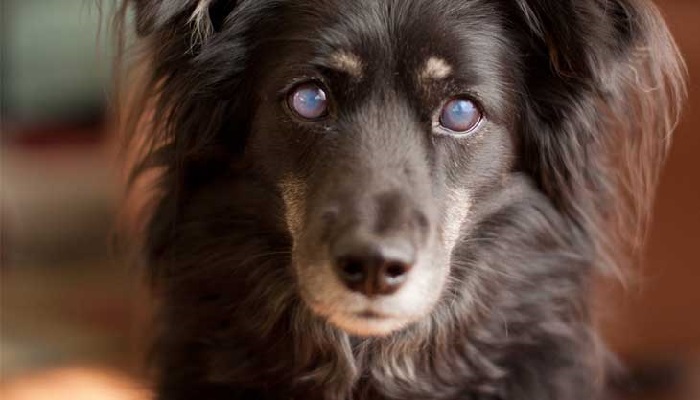Cataracts, characterized by the clouding of the normally clear lens of the eye, are a prevalent eye condition among canine companions. While cataracts often develop with age, they can also arise due to various underlying causes, including genetics, trauma, and systemic diseases. Recognizing cataracts early and understanding the available treatment options are crucial for ensuring the well-being and quality of life for affected dogs. This comprehensive guide delves into the signs, causes, and treatment options for cataracts in dogs, empowering pet owners with the knowledge to make informed decisions and provide optimal care for their beloved furry friends.

Recognizing Cataracts in Dogs: Signs and Symptoms
Cataracts manifest in various forms and stages of progression. Recognizing the early signs of cataracts is essential for timely intervention and management. Here are some common signs and symptoms to watch out for:
Cloudy or Hazy Eyes
One of the most noticeable signs is the appearance of a cloudy or hazy film over the eye’s pupil. The cloudiness may be slight initially but can gradually intensify over time. This cloudiness can affect one or both eyes and can be seen as a whitish or bluish tint over the eye. In some cases, the cloudiness may only be visible when light is shone directly into the eye.
Vision Impairment
As cataracts progress, they can cause progressive vision impairment. Dogs may exhibit difficulty navigating familiar spaces, bumping into objects, or showing reluctance to engage in activities requiring sharp vision. They may also have trouble seeing in low light conditions or may become more hesitant to go outside at night. In severe cases, cataracts can lead to complete blindness.
Changes in Eye Color
In addition to cloudiness, cataracts can also cause changes in the color of the eye. The affected eye may appear darker or more yellowish compared to the unaffected eye. This is due to the clouding of the lens, which can affect the way light enters the eye and reflects off the retina.
Causes of Cataracts in Canine Companions

While cataracts are commonly associated with aging, they can also be caused by various underlying factors. Here are some of the most common causes of cataracts in dogs:
Genetics
In some cases, cataracts can be inherited from a dog’s parents. Certain breeds, such as Poodles, Cocker Spaniels, and Boston Terriers, are more prone to developing cataracts due to genetic predisposition. In these cases, cataracts can develop at a younger age, sometimes even as early as a few months old.
Trauma
Injuries to the eye, such as blunt force trauma or penetrating injuries, can also lead to the development of cataracts. These injuries can damage the lens, causing it to become cloudy and impairing vision. Dogs who engage in high-risk activities, such as hunting or agility training, may be more prone to eye injuries that can result in cataracts.
Systemic Diseases
Certain systemic diseases, such as diabetes and hypothyroidism, can also increase the risk of cataract development in dogs. These conditions can cause changes in the metabolism and blood supply to the eye, leading to the formation of cataracts. It is essential for pet owners to monitor their dog’s overall health and manage any underlying conditions to help prevent cataracts from developing.
Treatment Options for Canine Cataracts
The treatment options for cataracts in dogs depend on the severity of the condition and the overall health of the dog. In mild cases, where the cataracts do not significantly impair vision, no treatment may be necessary. However, in more severe cases, treatment may be required to restore vision and improve the dog’s quality of life. Here are some of the most common treatment options for canine cataracts:
Surgical Intervention
Surgery is the most effective treatment for cataracts in dogs, especially in cases where the cataracts have significantly impaired vision. During the procedure, the cloudy lens is removed and replaced with an artificial lens, restoring clear vision. This surgery is typically performed by a veterinary ophthalmologist and requires general anesthesia.
Restoring Vision in Dogs with Cataracts
Surgical intervention can significantly improve a dog’s vision and quality of life. In most cases, dogs will regain their vision within a few days after surgery, although it may take a few weeks for them to fully adjust to their new lens. The success rate of cataract surgery in dogs is high, with over 90% of dogs regaining their vision after the procedure.
Potential Risks and Complications
As with any surgical procedure, there are potential risks and complications associated with cataract surgery in dogs. These include infection, bleeding, and inflammation. It is crucial to follow post-operative care instructions carefully to minimize these risks and ensure a successful outcome.
Non-Surgical Approaches to Managing Cataracts in Dogs
In cases where surgery is not a viable option, or if pet owners prefer a non-invasive approach, there are alternative treatments available. These include topical eye drops and supplements that aim to slow down the progression of cataracts and improve overall eye health. While these treatments may not reverse cataracts, they can help manage the condition and delay the need for surgery.
Progression and Long-Term Outlook for Dogs with Cataracts

The progression of cataracts in dogs varies depending on the underlying cause, the severity of the condition, and the age of the dog. In some cases, cataracts may develop slowly over time, while in others, they may progress rapidly. It is essential to monitor your dog’s vision regularly and consult with a veterinarian if you notice any changes.
In most cases, cataracts will continue to progress if left untreated, eventually leading to complete blindness. However, with timely intervention and proper management, the long-term outlook for dogs with cataracts can be positive. Surgical intervention can restore vision, while non-surgical approaches can help slow down the progression of the condition.
Caring for Dogs with Cataracts: Nutritional and Environmental Considerations
Proper nutrition and environmental factors can play a significant role in managing cataracts in dogs. A diet rich in antioxidants, such as vitamins A, C, and E, can help support eye health and potentially slow down the progression of cataracts. Additionally, ensuring a safe and stress-free environment for your dog can also help prevent injuries that may lead to cataracts.
Preventing Cataracts in Dogs: A Proactive Approach
While not all cases of cataracts can be prevented, there are steps pet owners can take to reduce their dog’s risk of developing this condition. Regular check-ups with a veterinarian can help identify any underlying health issues that may increase the risk of cataracts. Additionally, avoiding activities that may cause eye injuries, such as rough play or contact sports, can also help prevent cataracts from developing.
Conclusion
Cataracts are a common eye condition in dogs that can significantly impact their quality of life. Recognizing the signs and causes of cataracts is crucial for timely intervention and management. While surgery is the most effective treatment option, alternative approaches can also help manage the condition. With proper care and proactive measures, pet owners can help ensure their canine companions live happy and healthy lives, even with cataracts.
